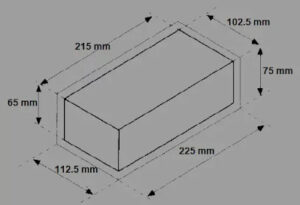Properties of good bricks | Different class of bricks
The following properties of bricks
Size and shape
Size
and shape –
Should have uniform size and plane and rectangular surfaces with parallel sides
and sharp straight edges.
20
bricks of standard size (190 mm ╳ 90 mm ╳ 90 mm) are selected at random and they
are stacked length wise, along the width and height.
 |
| Brick Size |
For a good brick result should be within the
following permissible limit.
Length – 3680mm to 3920mm
Width – 1740mm to 1860mm
Height – 1740mm to 1860mm
Water absorption
Water
absorption –
taken and it is weighed dry then it is immersed in water for 24 hours. and
again weight. For a good brick, water absorption after 24 hours of immersion,
water absorption should be 20% and in no case absorption should exceed 20%.
Crushing strength
Crushing
strength –
placing it in the compression testing machine. As per IS 1077 : 1970,
minimum compressive strength of brick is 3.5 N/mm.
For a good brick compressive strength >10N/mm2.
Grade A brick – 7 – 14 N/mm2
Grade B brick – 14N/mm
Hardness
Hardness –
the brick surface with the help of a fingernail. If no impression is left on
the surface the brick is to be treated sufficiently hard.
Soundness
Soundness – Properties of a good brick for the soundness test, When two similar bricks struck
together. A metallic sound should be produced.
Texture and compactness
Texture and compactness –
is examined. It should be homogeneous, compact and free from any defects such
as holes, lums etc.
Colour
Colour – Brick should be uniformly dark red or cherry colour as
indicated for uniformity in chemical composition and completeness in burning of
brick.
Presence of soluble salts / Efflorescence
Presence of soluble salts / Efflorescence –
efflorescence on the surface of the brick. After 24 hours immersion in water
and allowed to dry in Shade, it should not show so any grey or white deposit on
its surface (i,e showing absence of salt)
Classification of bricks
First class brick
- The crushing strength compressive strength of
first class brick is 105 kg/㎠ (10.5 N/㎟)
- The water absorption of first class brick should
not be more than 20% of dry weight (⊁20%)
- First class brick is a smooth surface, sharp and
straight edges parallel and square corner.
- The thickness of mortar joint is 10 mm.
- In first class brick when a scratch is made by a
nail finger no impression should be left on the brick.
- The colour of the first class brick is a cherry
and red colour.
- Uniform texture of brick.
- Thoroughly burnt.
- When two bricks are struck each other then
metallic sound is to be produced.
- First class brick is used for pointing, exposed
face work in masonry structure.
- First class brick is to be used for exterior
brick work or load bearing wall.
Second class brick
- The crushing strength compressive strength of
second class brick is 70 kg/㎠ (7 N/㎟)
- The water absorption of second class brick should
not be more than 22% of dry weight (⊁22%)
- Second class brick is a smooth surface, and edges
are defective and rectangular in shape.
- The thickness of mortar joint is 12 mm.
- The colour of the second class brick is a yellow
and red colour.
- When two similar bricks are struck each other
then metallic sound is to be produced.
- In second class brick when a scratch is made by a
nail finger no impression should be left on the brick.
- Thoroughly burnt.
- Second class brick is to be used for interior
brick works or load bearing walls.
Third class brick
- The crushing strength
compressive strength of third class brick is 50 kg/㎠ (5 N/㎟)
- The water absorption of third
class brick should not be more than 24 – 25 % of its dry weight (24 – 25 %)
- Shape distorted and size is not regular.
- In third class brick texture
is non – uniform.
- The colour of the third class
brick is light red.
- Third class brick is to be
used for interior brick works.
- This brick is only for used
partition wall, cavity wall, sleeper wall and non-loading bearing wall or temporary structure.
Fourth class bricks
- The crushing strength compressive strength of
fourth class brick is around 400 kg/㎠ (40 N/㎟)
- The water absorption of fourth class brick is 20%
of dry weight (20%) – IS CODE 1077-1992
- We get this type of brick by over burning. It is also called over
burn brick or jhama brick.
- For more burning, a soft molten mass is produced and the bricks
lose their shape.
- Over burn brick is used for filing purposes.
Common building bricks
- The crushing strength compressive strength of
first class brick is 35 kg/㎠ (3.5 N/㎟)
- The water absorption of common building brick
should not be more than 25% of its dry weight (⊁25%)
- IS CODE
1077:1976



Pingback: What is brick | Size of bricks | Composition – Types of brick | Brick bond | Type of brick bond – civilnotebook.com
Pingback: What is timber | Types of timber | Advantages and disadvantages of timber - civilnotebook.com
Pingback: Piles | Types of Piles | Concrete Piles | Steel Piles | Timber Piles | Composite Piles | Advantages & Disadvantages Of Piles - civilnotebook.com
Pingback: 10 by 40 house plan | Submission drawing with estimate | PDF